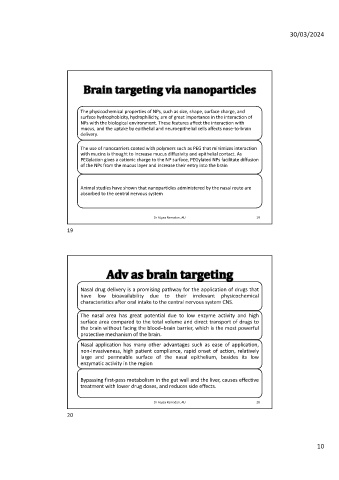Page 222 - Pharmaceutics IV (02-06-01305)
P. 222
30/03/2024
The physicochemical properties of NPs, such as size, shape, surface charge, and
surface hydrophobicity, hydrophilicity, are of great importance in the interaction of
NPs with the biological environment. These features affect the interaction with
mucus, and the uptake by epithelial and neuroepithelial cells affects nose-to-brain
delivery.
The use of nanocarriers coated with polymers such as PEG that minimizes interaction
with mucins is thought to increase mucus diffusivity and epithelial contact. As
PEGylation gives a cationic charge to the NP surface, PEGylated NPs facilitate diffusion
of the NPs from the mucus layer and increase their entry into the brain
Animal studies have shown that nanoparticles administered by the nasal route are
absorbed to the central nervous system
Dr ALyaa Ramadan, AU 19
19
Nasal drug delivery is a promising pathway for the application of drugs that
have low bioavailability due to their irrelevant physicochemical
characteristics after oral intake to the central nervous system CNS.
The nasal area has great potential due to low enzyme activity and high
surface area compared to the total volume and direct transport of drugs to
the brain without facing the blood–brain barrier, which is the most powerful
protective mechanism of the brain.
Nasal application has many other advantages such as ease of application,
non-invasiveness, high patient compliance, rapid onset of action, relatively
large and permeable surface of the nasal epithelium, besides its low
enzymatic activity in the region
Bypassing first-pass metabolism in the gut wall and the liver, causes effective
treatment with lower drug doses, and reduces side effects.
Dr ALyaa Ramadan, AU 20
20
10

